 |
 #INTHEAIREVERYWHERE
#INTHEAIREVERYWHERE |
|
| Vol.
17 No. 52 |
Tuesday
August 21, 2018 |
 |
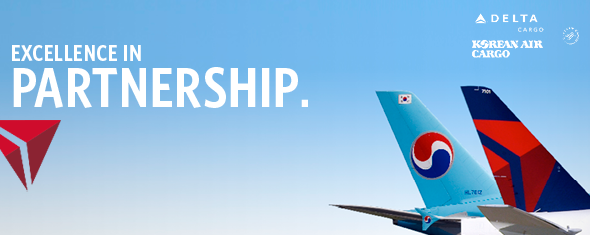 |
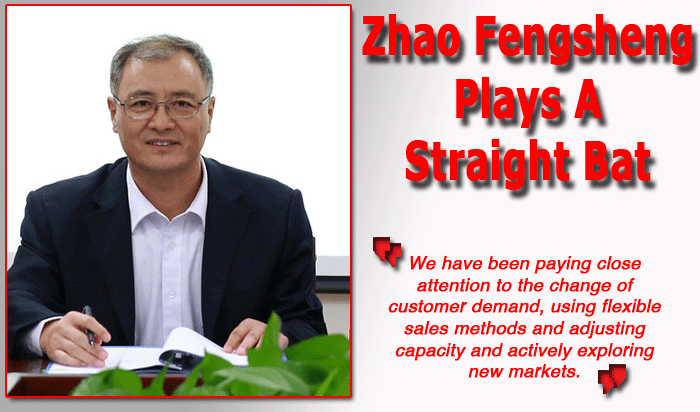
China
Southern Cargo currently
faces challenges on
multiple fronts, but
most obviously from
the escalating Sino-U.S.
trade war which threatens
its Transpacific business.
It’s
All Cricket
When
FlyingTypers
recently caught up
with Zhao Fengsheng,
Senior Vice President
of the carrier’s
Cargo Division, he
was optimistic about
the year ahead although
on tariffs, to use
an old English cricketing
idiom, he played a
decidedly straight
bat.
The
Tariffs
Asked
how China Southern
had coped with the
imposition of tariffs
by both the U.S. and
China and the threat
of more to come, Zhao
admitted the Transpacific
trade was crucial
to CZ’s freight
business plan, but
was hesitant to discuss
the topic in detail.
“We
have been paying close
attention to the change
of customer demand,
using flexible sales
methods and adjusting
capacity and actively
exploring new markets,”
was all FlyingTypers
could draw from him.
Stable
Market Two Percent
Growth
Mr.
Zhao was more forthcoming
when discussing the
health of freight
markets this year.
“So
far in 2018, the air
cargo market has been
stable overall,”
he said.
“But
the market demand
growth is not as good
as the same period
in 2017.
According
to preliminary statistics,
in the first five
months of this year,
the freight and mail
transportation volume
and revenue of China
Southern Cargo Airlines
have achieved a moderate
growth, with cargo
volume increasing
by 2% year-on-year.”
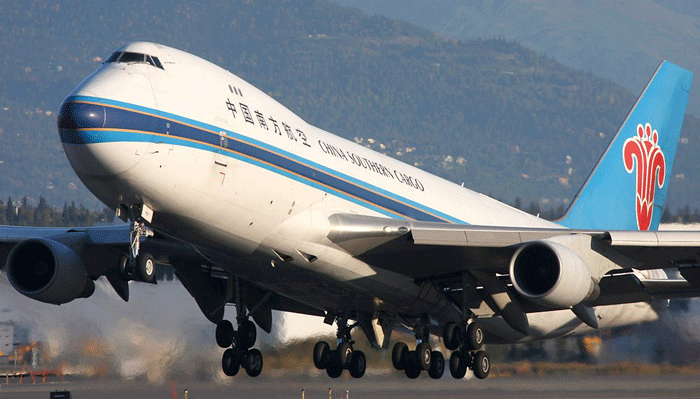 |
Demand
By Region
Mr.
Zhao said China-Europe
demand had been “stable”
this year, while intra-Asia
cargo demand had been
dynamic, prompting
service roll-outs.
“China
Southern Airlines
began to operate Guangzhou-Vietnam-Guangzhou
route by B747 freighter
on September 24, 2015,
two flights per week,”
he said.
“Up
to the end of May
2018, CZ has operated
more than 500 flights.
Over 19,000 tons of
goods has been shipped
from Vietnam to China,
Europe and the United
States through this
route, and more than
5,000 tons of them
has been transported
to Europe Via China.”
Exceptional
2017 Sets Bar High
Like
most carriers, 2017
was exceptional for
CZ, all the more so
because after years
of relatively slow
growth the rebound
was unexpected. CZ
certainly took advantage
- revenue from freight
and mail transportation
increased by 26.3%
year-on-year while
profit from freight
operations reached
CNY651 million (USD$97m),
the carrier’s
best ever financial
performance.
“We
did have expectations
of recovery of the
air cargo market in
2017, but the bounce
was better than what
we expected,”
explained Mr. Zhao.
“On
the one hand, the
cyclical upturn in
2017 was predictable.
"Based
on the IATA data,
the air cargo market
demand was weak in
the first three quarters
of 2016 and the cargo
capacity growth of
the Asia-Pacific airlines
slowed sharply, which
was only half the
growth rate of the
same period of 2015.
In the fourth quarter
of 2016, the market
demand started to
rebound significantly,
but the slow capacity
growth situation held
out until the third
quarter of 2017, resulting
in great improvements
in revenue in 2017.
Recovery
Was A Surprise
“On
the other hand, the
strength of the recovery
had largely topped
market participants’
forecasts in 2017.
“European
and U.S. economies
had gone through a
strong recovery, with
manufacturing industry
rapidly transforming
from smooth running
to accelerating expansion
and the unemployment
rate gradually declining
to a record low.
“Against
this background, global
business inventories
were short, and U.S.
enterprises suffered
a continued decline
of the Inventories
to Sales Ratio during
2016 – 2017.
“In
order to restock inventories,
enterprises had to
take advantage of
the time-sensitive
air freight offering,
so this was a driver
during the economic
recovery,” Mr.
Zhao said.
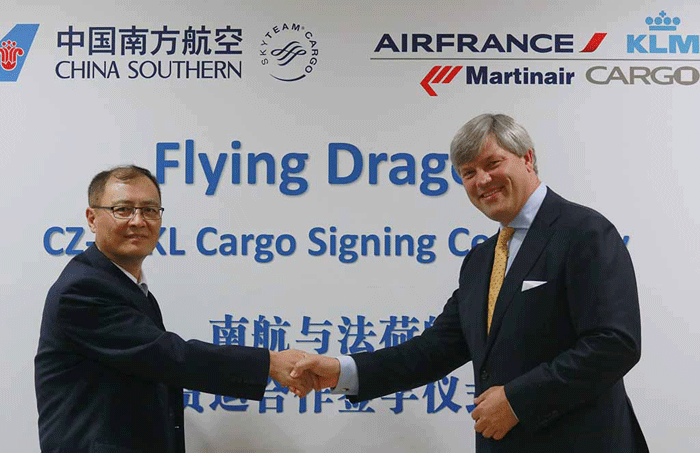
All smiles—Mr.
Zhao Fengsheng,
SVP China Southern
Cargo and Mr.
Marcel de Nooijer,
EVP, Air France
KLM Martinair
Cargo after signing
the October 2017
Memorandum of
Understanding. |
The
Air France Connection
CZ
continues to benefit
from its ongoing and
long-standing cooperation
with Air France KLM
Martinair Cargo. The
carriers first signed
a freighter cooperation
agreement in 2003,
but this was stepped
up in 2015 when a
Memorandum Of Understanding
was signed endorsing
a mutual cooperation
plan.
“In
October 2017, the
MOU was further updated
with an aim to further
enhance mutual benefit
and collaboration
to the maximum advantage,”
explained Zhao.
“Our
cargo cooperation
is mainly in cargo
and mail interlining,
which covers mutual
access to the airlines’
respective networks
and provides our customers
with an extensive
global reach.
“During
these years, cargo
destinations we jointly
serve increased to
24, mail destinations
up to 55, the scope
of interlining expanded
from general cargo
to mail and perishables
such as flowers, fruits,
etc.
“In
addition, we added
‘Block Space’
cooperation to the
existing interlining
since November 2017,
and plan to extend
this.
“Based
on the solid foundation
we have jointly built,
I believe we can work
out better results
in 2018 and beyond,
in terms of added
value to customers,
reaching new markets,
generating revenue
and sharing best practices.”
SkyKing
|
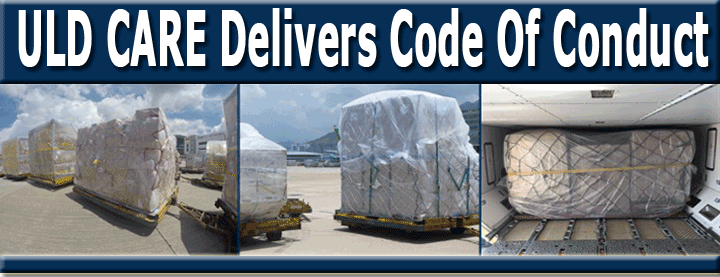
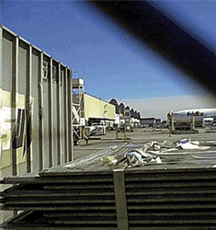 A
ULD being loaded
onto the main deck
or slipped into
the belly of a wide
body passenger aircraft
is the money shot
in any air cargo
message of late. A
ULD being loaded
onto the main deck
or slipped into
the belly of a wide
body passenger aircraft
is the money shot
in any air cargo
message of late.
But
what about the ULDs,
aka “silent
partners,”
of our air cargo
enterprise?
Watching
the daily ballet
of ULDs being loaded
and unloaded from
aircraft at the
airport, it is easy
to step back a bit
and wonder about
the stories they
might tell.
I
recall just a couple
years ago out at
JFK Airport casting
a long steady gaze
at a somewhat dented
can sitting alongside
the old Lufthansa
Building 260, the
airport facility
where the German
carrier pioneered
all-cargo main deck
B747F service from
Frankfurt to New
York in 1972.
But
this can had the
words “Seaboard
World” printed
on it and that brought
back even more memories
to a time when SWA
and LAAC operated
competing B747Fs
across the Atlantic
from adjacent cargo
facilities at JFK.
Not Alone In My
Thoughts
 When
it comes to ULDs
in 2018 and beyond,
the “Go-To
Guys” are
Bob Rogers and Urs
Wiesendanger. When
it comes to ULDs
in 2018 and beyond,
the “Go-To
Guys” are
Bob Rogers and Urs
Wiesendanger.
Both
have served over
the years as lightening
rods for a Canadian
organization devoted
to ULDs called ULD
CARE.
ULD
CARE is a not-for-profit
corporation.
Having
started life in
the 70s as an IATA
special interest
group (then named
the Interline ULD
User Group-IULDUG)
and subsequently
split off to become
an independent not-for-profit
entity, ULD CARE
retains a close
link to IATA through
an MOU.
ULD
CARE also maintains
a close contact
with the Cargo Focus
Group at the FAA.
Its
membership is open
to organizations
whose scope encompasses
any aircraft unit
load device (ULD)
activity.
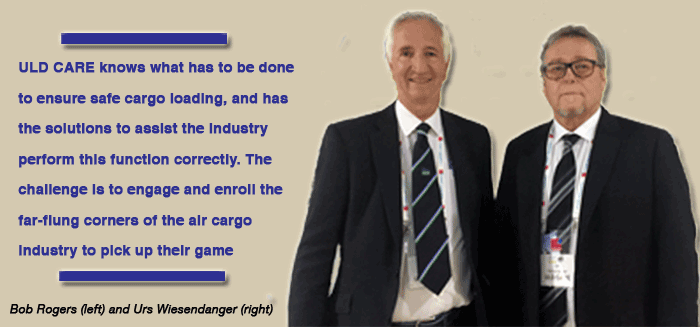 |
The
Two & Only
How
great to encounter
the two most activist
ULD spokesmen in
the world, Urs Wiesendanger,
President, ULD CARE,
Air Canada (retired),
and Bob Rogers,
Vice President ULD
CARE, Senior Advisor
Nordisk, at the
recent IATA World
Cargo Symposium
in Dallas, Texas.
The
dynamic duo Urs
& Bob make their
case, pulling no
punches, keeping
it simple, laying
it on the line.
“ULD
CARE is at the forefront
in advancing compliant,
safe, and efficient
ULD operations,”
Bob Rogers told
FlyingTypers.
“Over
the past 40 years,
we have evolved
from an interlining
tracking system
to a provider of
comprehensive solutions
that advance ULD
handling for the
air cargo industry.”
ULDs
Taken For Granted
“The
global air cargo
industry,”
Bob Rogers said,
“faces many
challenges and demands,
and with a few exceptions
ULD operations are
taken for granted,
expected to be available
and useable when
needed, but often
put to use in conditions
characterised by
inadequate infrastructure
and under trained
personnel, totally
unsuitable for what
are essentially
aircraft equipment
that perform an
essential flight
safety function
and are not just
a piece of material
handling equipment
(MHE).”
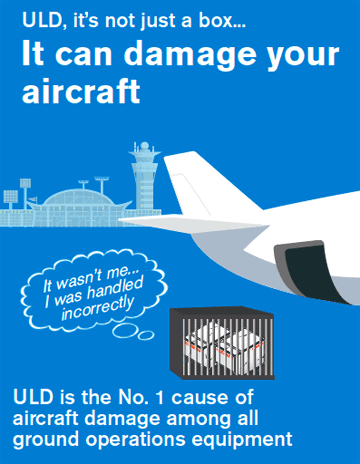 A
Fatal Flaw A
Fatal Flaw
Major
(fatal) crashes
in 1997 (Fine Air
101) and 2013 (National
Air Cargo), both
attributable to
non-complaint cargo
restraint leading
to cargo shift and
loss of control
of the aircraft,
require a “sea
change” in
the approach to
safety around cargo
loading. All too
often, the basics
of weight and balance
compliance and load
restraint are overshadowed
by DG and security.
“There
is today a significant
gap between what
at least some national
aviation authorities
(NAAs) including
the FAA expect from
the airlines under
their jurisdiction
in terms of ULD
operations, while
on the other hand
the unregulated
ground handling,
cargo terminal,
and freight forwarding
sectors places very
limited attention
on ensuring that
only airworthy ULD
loaded correctly
are delivered to
the aircraft and
that handling infrastructure
and activities minimize
the damage to ULD,
which are lightweight
aircraft equipment,
and not some piece
of MHE to be hammered
around the warehouse
or ramp,”
Bob Rogers said.
ULD
CARE Punches Above
Its Weight
“In
its ongoing evolution,
ULD CARE’s
primary focus is
to first create
solutions that will
support the correct
use of ULDs and
then promote these
solutions using
the limited resources
of ULD CARE,”
said Urs.
“As
a not-for-profit
trade association,
we rely very much
on the efforts of
volunteers to give
their time and expertise,
however we believe
that with the portfolio
we now bring to
the industry, ULD
CARE punches well
above its weight.”
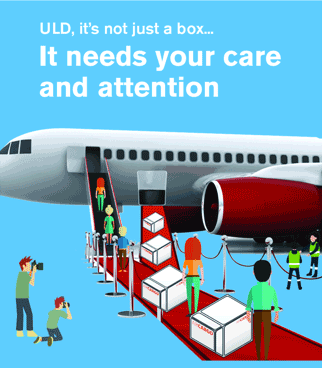 Time
For Code Of Conduct Time
For Code Of Conduct
“2018
sees the launch
of the ULD Code
of Conduct, a first
for this industry,”
Mr. Rogers declares.
“CofCs are
widespread in many
industries but are
not common in aviation
due to the highly
regulated nature
of aviation.
“However,
ground handling,
cargo terminal,
and freight forwarder
activities fall
outside the aviation
regulatory footprint,
and with the airlines
having outsourced
these activities
there exists a considerable
vacuum when it comes
to adequate ULD
operations.
“Individual
airlines may well
have their own campaigns
to promote quality
in ULD operations,
but against an overwhelming
lack of awareness
(interest?) across
the various sectors
of the industry,
one airline will
struggle to achieve
anything significant,”
Bob Rogers added.
ULD
Care Challenges
Ahead
“Air
Cargo is a multibillion
24/7 global operation
and making changes
is very challenging,
all too often it
takes major accident
to trigger sufficient
attention,”
Bob Rogers said.
“ULD
CARE knows what
has to be done to
ensure safe cargo
loading, and has
the solutions to
assist the industry
perform this function
correctly. The challenge
is to engage and
enroll the far-flung
corners of the air
cargo industry to
pick up their game.”
Why
ULD Code Of Conduct
Matters
“You
cannot go a week
without reading
about some new facility
for Pharma,”
Bob Rogers insists.
“Pharma
is a very, very
large part of air
cargo and attracts
a great deal of
interest.
“Yet
the treatment of
the costly and complex
Temperature Controlled
Containers that
are a foundation
of this activity
falls far short
of what is needed,
increasing both
operating costs
and operational
failures.
“Similarly,
Fire Containment
Covers and Fire
Resistant Containers
can provide a vital
layer of protection
against Lithium
Battery fires, a
major risk on some
trade lanes.
“But
these items are
both costly and
require proper handling,
so often are not
present in day to
day operations.”
“ULD
CARE’s primary
vehicle for change,”
Urs Wiesendanger
declares, “is
the ULD Code of
Conduct.”
“The
ULD CARE Code of
Conduct,”
Bob Rogers insists,
“introduces
an appropriate element
of quality into
ULD operations,
distilling down
into a simple, easy
to comprehend statement
of intent the core
principles applicable
to flight safe ULD
operations and handling.
“Based
on and complimenting
the IATA ULD Regulations,
which can be considered
to be the ‘bible’
for all ULD operations,
it is the intention
that the code become
the basis for ULD
operational standards
in organisations
regardless of size
and scale,”
he said.
Rally
Around The Banner
“ULD
CARE,” Bob
and Urs point up,
“remains the
only body dedicated
specifically to
the promulgation
of ULD practices.
“With
around 65 airline
members and about
25 related members
such as ULD manufacturers,
ULD CARE is in a
unique position
to drive ULD specific
initiatives.
“In
terms of cooperations,
we look to similar
trade associations
such as ASA, industry
publications, freight
forwarder associations,
and anyone with
a vested interest
in improving ULD
operating standards
to assist in driving
our message outward.”
When
Is The Mission Accomplished?
“Easy
answer,” is
the word in chorus.
“ULD
CARE strives for
100 percent safe
ULDs on aircraft,
supported by ground
operations that
use adequate facilities
and infrastructure
and staffed with
adequately trained
personnel who know
the difference between
right and wrong
when it comes to
ULD!
“Perhaps
such an ambition
wont happen overnight,
and no doubt adoption
will take time.
“But
every bit is a step
in the right direction.
“Ideally
if a number of the
larger entities
take the Code of
Conduct on board,
we will gain momentum.”
https://www.uldcare.com/
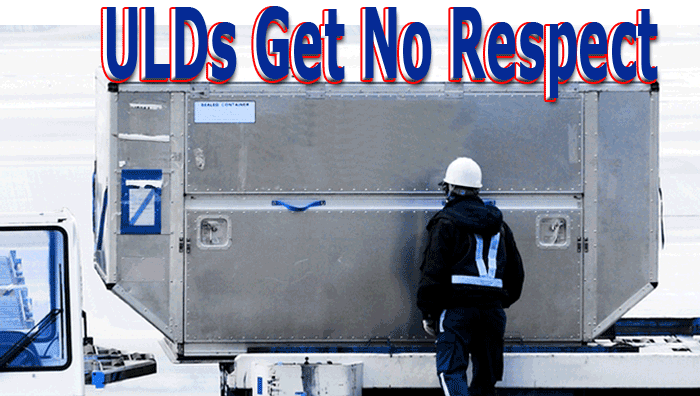
A
common saying
goes, “you
can’t
see the forest
for the trees.”
This
also seems to
be true for
the ULD (or
Unit Load Device).
Most
everyone in
the air cargo
business can
identify the
common types
of ULDs and
has seen them
in all-day use
for the purpose
of carrying
cargo, mail,
and baggage.
Few
people, however,
are familiar
with the latest
developments
around ULDs,
the requirements
applicable to
their use, and
the regulatory
background edicts
for their usage.
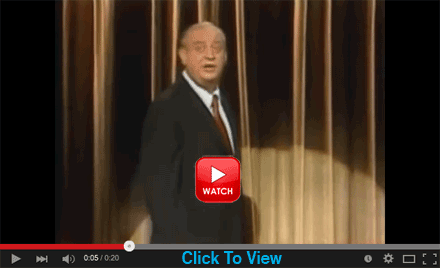 Thinking
about ULDs and
their common
perception in
our business,
we are reminded
of the great
American comedian
Rodney Dangerfield
who used to
tell his audience
about his woes
and travails: Thinking
about ULDs and
their common
perception in
our business,
we are reminded
of the great
American comedian
Rodney Dangerfield
who used to
tell his audience
about his woes
and travails:
“You
see, I get no
respect,”
Rodney would
say, and that
phrase usually
brought down
the house.
Legally
speaking, ULDs
are part of
the aircraft’s
equipment and
thus subject
to stringent
airworthiness
requirements.
In
other words:
A surplus
of missing rivets,
damaged doors
or locks, bent
edges, broken
base plates
as well as improper
repairs, the
wrong tiedown
equipment, and
overload or
unevenly distributed
load will cause
the ULD to be
used out of
its specifications
and thus not
be in compliance
with applicable
FAA, EASA, and
IATA rules.
Aircraft
manufacturers
including Airbus
and Boeing as
well as ULD
manufacturers
have developed
stringent guidelines
which, apart
from airline-internal
guidance such
as the COM (Cargo
Operations Manual)
or the ASM (Airport
Services Manual)
can most easily
be viewed in
the IATA AHM
(Airport Handling
Manual) in its
current 38th
Edition and
the IATA ULD
Regulations
in its current
6th edition
(the IATA ULD
regulations
have replaced
the IATA UTM,
the ULD Technical
Manual, about
three years
ago, when the
manual was revamped
and substantially
updated).
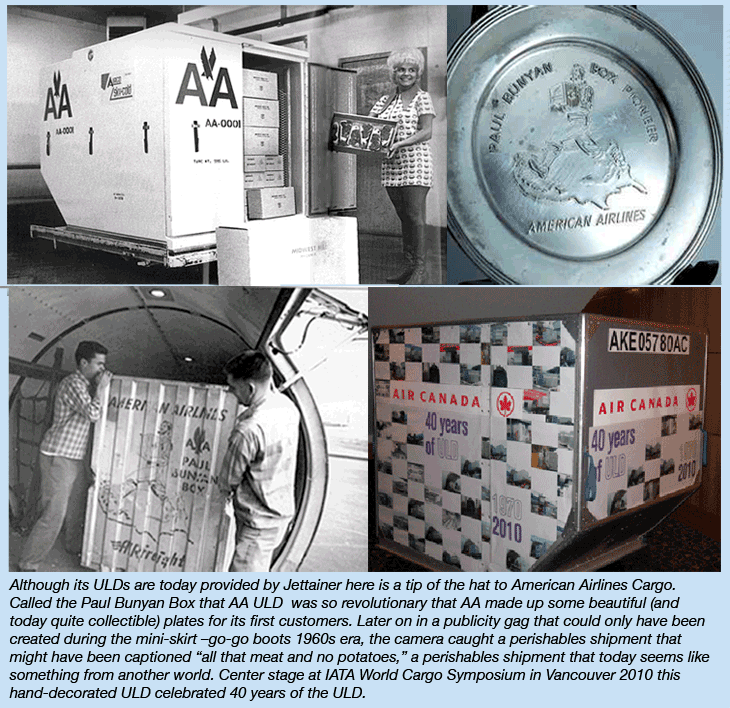 |
Geoffrey
|
 |
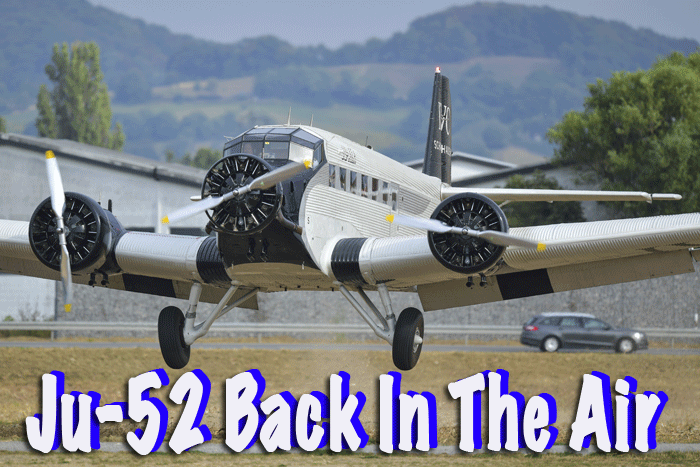
A
Ju-52 passenger aircraft
of the Swiss airline
Ju-Air lands last Friday.
It
is the airline's first
flight after the crash
on August 4, 2018 of
one of its classic aircraft
in the Swiss Alps resulting
in 20 fatalities.
“JU-AIR
immediately and voluntarily
suspended its flight
operations as a sign
of respect for the dead
and their families and
friends, and to give
the team at JU-AIR time
to begin the process
of overcoming the accident,”
JU-AIR said.
“The
Swiss Federal Office
of Civil Aviation has
declared that there
is no reason why the
Ju-52s of JU-AIR should
not be allowed to fly,”
the company said, adding:
“Swiss
Transportation Safety
Investigation Board
STSB gives no cause
to doubt the operational
safety of our airplanes.”
“Should
the investigations bring
forth any findings that
put in question the
safety of our flight
operations, we would
immediately suspend
them once again.”
The
JU-AIR fleet currently
operates three vintage
Ju-52s that were built
in 1939 and in service
with the Swiss Air Force
before being retired
in 1981. |
Publisher-Geoffrey
Arend • Managing Editor-Flossie Arend • Editor Emeritus-Richard
Malkin
Film Editor-Ralph Arend • Special Assignments-Sabiha Arend, Emily
Arend • Advertising Sales-Judy Miller |
 Send
comments and news to geoffrey@aircargonews.com Send
comments and news to geoffrey@aircargonews.com
Opinions and comments expressed herein do not necessarily reflect the
views of the publisher but remain solely those of the author(s).
 Air
Cargo News FlyingTypers reserves the right to edit all submissions
for length and content. All photos and written material submitted to
this publication become the property of All Cargo Media. Air
Cargo News FlyingTypers reserves the right to edit all submissions
for length and content. All photos and written material submitted to
this publication become the property of All Cargo Media.
All Cargo Media, Publishers of Air Cargo News Digital and FlyingTypers.
Copyright ©2018 ACM, Inc. All Rights Reserved.
More@ www.aircargonews.com
 100%
Green 100%
Green
|
|
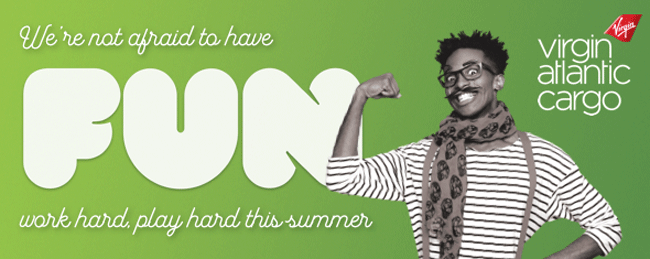



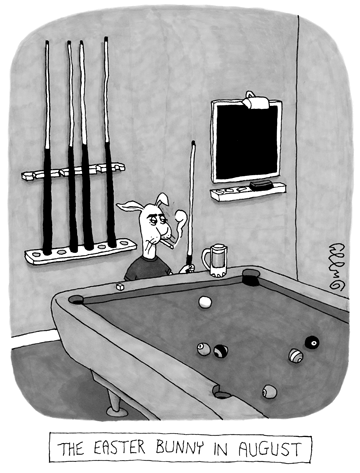



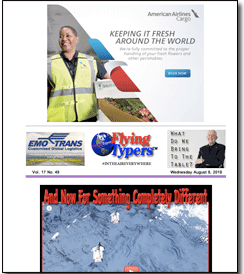 Vol.
17 No. 49
Vol.
17 No. 49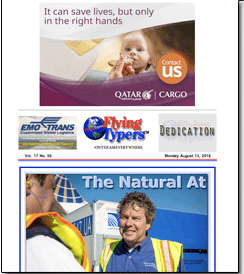 Vol.
17 No. 50
Vol.
17 No. 50




 A
ULD being loaded
onto the main deck
or slipped into
the belly of a wide
body passenger aircraft
is the money shot
in any air cargo
message of late.
A
ULD being loaded
onto the main deck
or slipped into
the belly of a wide
body passenger aircraft
is the money shot
in any air cargo
message of late. When
it comes to ULDs
in 2018 and beyond,
the “Go-To
Guys” are
Bob Rogers and Urs
Wiesendanger.
When
it comes to ULDs
in 2018 and beyond,
the “Go-To
Guys” are
Bob Rogers and Urs
Wiesendanger.
 A
Fatal Flaw
A
Fatal Flaw  Time
For Code Of Conduct
Time
For Code Of Conduct



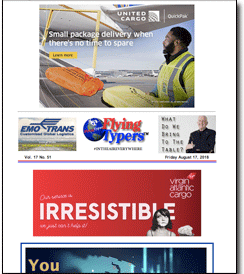
 Air
Cargo News FlyingTypers reserves the right to edit all submissions
for length and content. All photos and written material submitted to
this publication become the property of All Cargo Media.
Air
Cargo News FlyingTypers reserves the right to edit all submissions
for length and content. All photos and written material submitted to
this publication become the property of All Cargo Media.